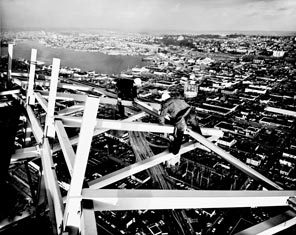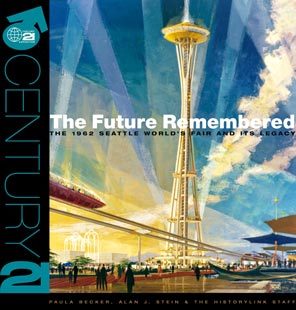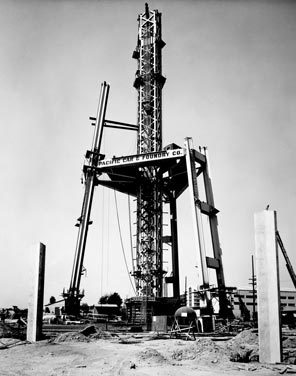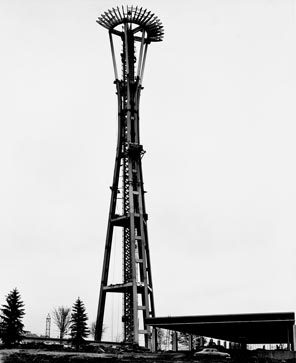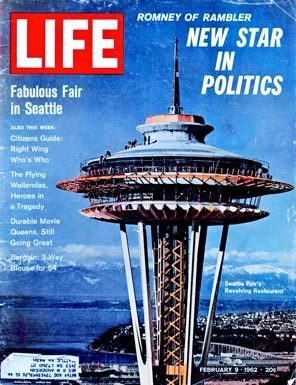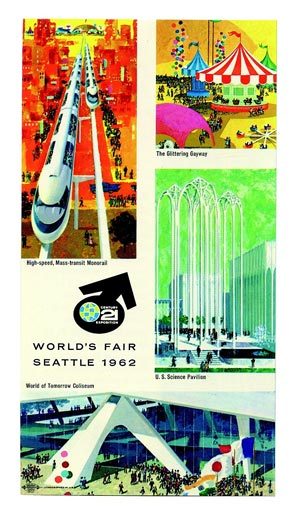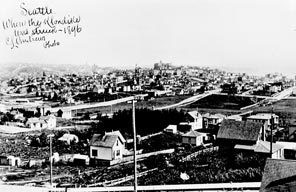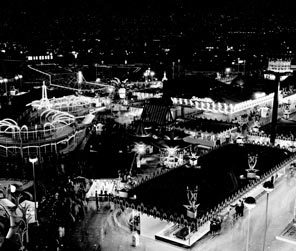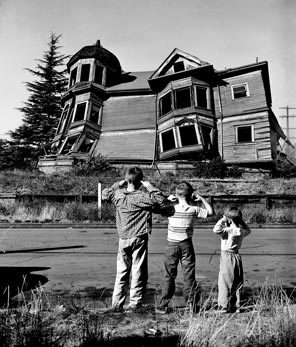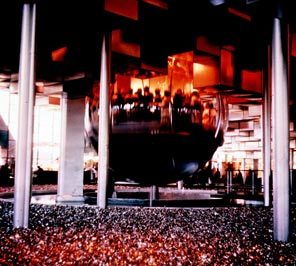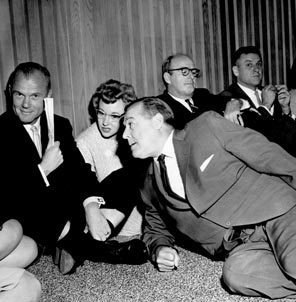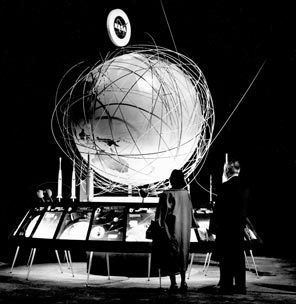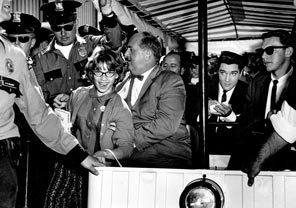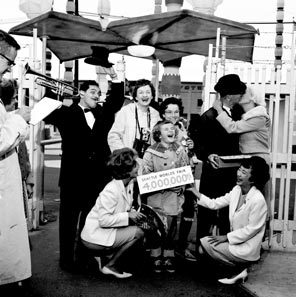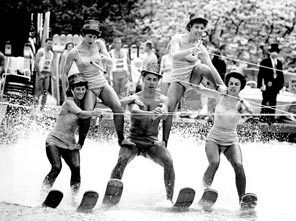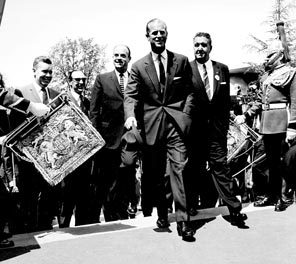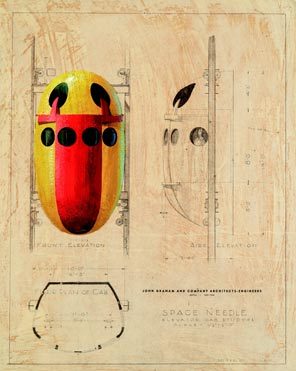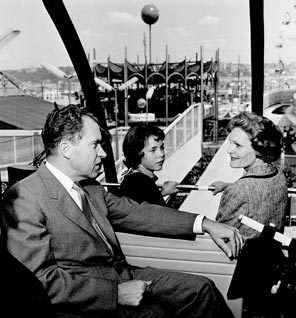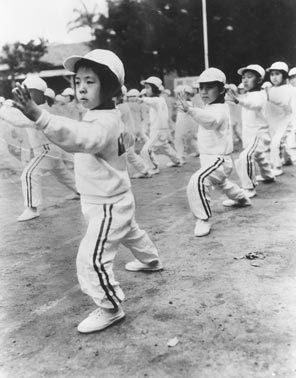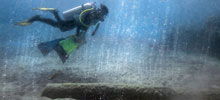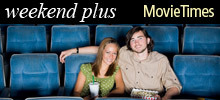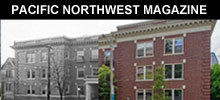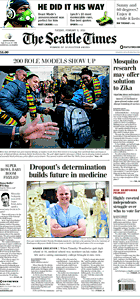Originally published October 15, 2011 at 10:00 PM | Page modified October 16, 2011 at 3:14 PM
They wrote the book on Seattle's World's Fair
Oct. 21, 2011, marks the six-month countdown to The Next Fifty, the 50th anniversary of the 1962 Seattle World's Fair. Seattle Center Foundation will announce programming for the celebration, as well as release a new official commemorative book.
COURTESY OF MUSEUM OF HISTORY & INDUSTRY
Construction workers check the joists on the Space Needle as work on the landmark progressed in the fall of 1961. Eddie Carlson, executive vice president of Western Hotels and chairman of the Washington World's Fair Commission, conceived of the Needle after dining atop a television tower in Stuttgart, Germany. The photo by Ralph Crane appeared in LIFE magazine.
Oct. 21, 2011, marks the six-month countdown to The Next Fifty, the 50th anniversary of the 1962 Seattle World's Fair. Seattle Center Foundation will announce programming for the celebration, as well as release the new official commemorative book, "The Future Remembered: The 1962 Seattle World's Fair And Its Legacy." Today's cover story and captions are excerpted from the 300-page coffee-table book, written by HistoryLink.org staff historians Paula Becker and Alan J. Stein. The book will be available from Seattle Center Foundation, Amazon.com and local bookstores in November. The price is $39.95.
COURTESY OF MUSEUM OF HISTORY & INDUSTRY
Eddie Carlson, executive vice president of Western Hotels and chairman of the Washington World's Fair Commission, and real-estate developer Jim Douglas persuaded Seattle architect John Graham Jr. to design the Space Needle. After Carlson unsuccessfully sought funding from King County, businessman Bagley Wright joined forces with Alaska Steamship President Ned Skinner and Weyerhaeuser President Norton Clapp to assemble funding. With Graham and construction mogul Howard S. Wright, they formed Pentagram Corp., a private company, to build the Needle. Work began with a 35-foot-deep hole for the foundation. On May 22, 1961, workers began what was billed as the largest continuous concrete pour in the West. This would counterbalance the eventual 3,700 tons of steel used in the structure.
COURTESY OF MUSEUM OF HISTORY & INDUSTRY
Eddie Carlson, executive vice president of Western Hotels and chairman of the Washington World's Fair Commission, and real-estate developer Jim Douglas persuaded Seattle architect John Graham Jr. to design the Space Needle. After Carlson unsuccessfully sought funding from King County, businessman Bagley Wright joined forces with Alaska Steamship President Ned Skinner and Weyerhaeuser President Norton Clapp to assemble funding. With Graham and construction mogul Howard S. Wright, they formed Pentagram Corp., a private company, to build the Needle. Work began with a 35-foot-deep hole for the foundation. On May 22, 1961, workers began what was billed as the largest continuous concrete pour in the West. This would counterbalance the eventual 3,700 tons of steel used in the structure.
COURTESY OF MUSEUM OF HISTORY & INDUSTRY
Eddie Carlson, executive vice president of Western Hotels and chairman of the Washington World's Fair Commission, and real-estate developer Jim Douglas persuaded Seattle architect John Graham Jr. to design the Space Needle. After Carlson unsuccessfully sought funding from King County, businessman Bagley Wright joined forces with Alaska Steamship President Ned Skinner and Weyerhaeuser President Norton Clapp to assemble funding. With Graham and construction mogul Howard S. Wright, they formed Pentagram Corp., a private company, to build the Needle. Work began with a 35-foot-deep hole for the foundation. On May 22, 1961, workers began what was billed as the largest continuous concrete pour in the West. This would counterbalance the eventual 3,700 tons of steel used in the structure.
COURTESY OF SEATTLE CENTER
By the summer of 1961, fair public-relations director Jay Rockey told The Seattle Times that his office was receiving more than 1,000 out-of-state press clippings about Century 21 each month. LIFE came out with its cover story in February 1962. LIFE photographer Ralph Crane captured the Needle against a backdrop of mountains and bay. Years later, Rockey remembered this cover story as a turning point in the fair's success, capturing national attention.
COURTESY OF WASH. ST. ARCHIVES
A Century 21 brochure touted some of the fair's main attractions: the high-speed monorail, the fun-filled Gayway, the elegant U.S. Science Pavilion designed by Minoru Yamasaki and the futuristic Coliseum designed by Paul Thiry.
COURTESY OF PAUL DORPAT
The site chosen for the fair was an area early settlers dubbed "Potlatch Meadows" in the mistaken belief that the local indigenous people held their tribal festivals there. The area's first white residents, David and Louisa Denny, simply called it "the prairie." The Denny claim was bounded to the south by what is now Denny Way, to the north by Mercer Street, to the east by Fifth Avenue North and the west by Elliott Bay.
COURTESY OF WASH. ST. ARCHIVES
Each night after sundown, the Gayway beckoned with brilliant lights and the promise of fun. Using his connections to Disney and the amusement industry, amusements and concessions director George Whitney secured a $2 million contract with Conklin and Batt, North America's leading amusement-park experts, to design the Gayway, which included rides from France, Italy and West Germany. Among them, the Wild Mouse, a roller coaster with two-person cars that scattered and ran like, well, mice.
COURTESY OF WASH. ST. ARCHIVES
Demolition to make room for the fairgrounds began in November 1958. While it was a noisy, exciting scene that attracted neighborhood kids, it was an emotional parting for others. As a band played during demolition of the first home, owner Charles Burkman tearfully said, "There was no band music when we moved into it. I've had enough." In all, more than 200 houses, duplexes, multiplexes and commercial structures were removed.
MUSEUM OF HISTORY & INDUSTRY
The Bubbleator, a spherical glass elevator, took World of Tomorrow visitors at the Coliseum up into a "cloud" of 3,200 aluminum cubes showing a multimedia spectacle, "The Threshold and the Threat," with sights and sounds coming from all sides. In the presentation, the threat of nuclear war appears suddenly, and a family is portrayed in a fallout shelter. At the end, passengers hear part of President John F. Kennedy's inaugural speech in which he called for everyone to use the knowledge of the present to build a brighter future.
THE SEATTLE TIMES / COURTESY OF STEVE CAMP
In the NASA Pavilion, right, visitors caught up in the space race of the 1960s learned about the many satellites and space capsules that circled, or soon would be, circling the planet. In May, fairgoers tracked the triple-orbit flight of astronaut Scott Carpenter and his suspenseful re-entry landing 250 miles from his target. Actor Jack Lemmon was among the crowd, which erupted in cheers when Carpenter was found safe. Above left, astronaut John Glenn visited that same month, attracting crowds at the U.S. Science Pavilion. Here, he lounges on the floor with U.S. Sen. Warren Magnuson.
COURTESY OF WASH. ST. ARCHIVES
At the Boeing Spacearium while waiting to watch the film "House of Science."
RON DEROSA / SEATTLE TIMES FILE
In town to film "It Happened at the World's Fair," Elvis Presley caused a sensation. Police kept the peace as best they could, but a few fans got close enough to snare an autograph from "the King." Filming for the first scenes were on the Monorail red train. Local extras were hired at $10 a day.
COURTESY OF MUSEUM OF HISTORY & INDUSTRY
Gracie Hansen, a self-proclaimed "country girl" who'd been living in Morton, Lewis County, won the contract to operate Show Street's major nightclub after getting her boss at a Seattle bank to raise $90,000 to back her. "The apple tree in Paradise will be our symbol," she said, referring to her "Night in Paradise" Las Vegas-style showgirl revue. Here she feeds a bite of the forbidden fruit to one of her dancers who has just emerged from a paper apple.
COURTESY OF WASH. ST. ARCHIVES
The fair welcomed its 4 millionth visitor, 7-year-old Christine Graham, on July 13, 1962. Surrounded by her family and clowning fair officials, Christine was showered with gifts just inside the East Gate.
COURTESY OF SEATTLE CENTER
Performers in Tommy Bartlett's water-ski show attempt to form a human pyramid while rounding a curve in a specially built water track inside Memorial Stadium.
COURTESY OF BRYCE SEIDL COLLECTION
During British Week, his Royal Highness Prince Philip of Great Britain tours the fairgrounds with Ewen Dingwall, behind the prince at left, and Joseph Gandy, right. "Ding," formerly executive director of the Washington State Research Council, was the fair's first paid employee, charged with overseeing the interests of both the city and state, and eventually was named vice president and general manager of Century 21 Exposition, Inc. Exposition President Gandy had cofounded the Smith-Gandy Ford dealership and served as Seattle Chamber of Commerce president in 1956 and 1957.
COURTESY OF BRYCE SEIDL COLLECTION
Then-former Vice President Richard Nixon, daughter Julie Nixon and wife Pat ride the Seattle Center Monorail during their visit Aug. 9. Earlier that same week, a contingent from the Kennedy clan, led by U.S. Attorney General Robert Kennedy, had visited; Kennedy gave a stirring speech to a packed crowd of 800 at the Playhouse.
50th anniversary remembrances begin
Oct. 21, 2011, marks the six-month countdown to The Next Fifty, the 50th anniversary of the 1962 Seattle World's Fair. Seattle Center Foundation will announce programming for the celebration, as well as release the new official commemorative book, "The Future Remembered: The 1962 Seattle World's Fair And Its Legacy." Today's cover story and captions are excerpted from the 300-page coffee-table book, written by HistoryLink.org staff historians Paula Becker and Alan J. Stein. The book will be available from Seattle Center Foundation, Amazon.com and local bookstores in November. The price is $39.95.
World's Fair commemorative gifts
Choose from our collection of World's Fair gifts featuring photos and newspaper page fronts. Browse collection.
![]()
In October 1957, the world changed. With the Soviet launch of Sputnik we knew the 1962 Seattle World's Fair had to be more than a "Festival of the West" or a simple anniversary celebration of the 1909 Alaska-Yukon-Pacific Exposition (A-Y-P): It had to be a fair of, for and about the future. We owe a great deal to the talented men and women who turned this audacious idea into a transformative event that captured the imagination of the world, introduced Seattle as a global city and deliberately left our community a civic center that is thriving 50 years later. These community leaders created a solid core of civic culture that has radiated in multiple directions for decades, and ignited a spark of ingenuity and imagination that has helped shape our region.
Seattle Center, the vibrant civic center that is the fair's greatest legacy, is preparing to celebrate its 50th anniversary. This celebration, The Next Fifty, appropriately does more than just look back to the Seattle World's Fair: It once again ignites the creativity and vision of our community and looks toward our shared future.
— from the Foreword by Jay Rockey, director of public relations and advertising for Century 21 Exposition, Inc.
Introduction
Century 21 Exposition — the 1962 Seattle World's Fair — was called into being by civic leaders with a vision who would not hear "No." Their dual purpose: to celebrate their city while stimulating its growth, and to create the enduring legacy of a permanent civic center, which became Seattle Center. The audacity of building a world's fair specifically to leave so much behind is stunning, still, innovative beyond the thinking of any other exposition.
Some fairs, like the World's Columbian Exposition of 1893 in Chicago and the 1904 Louisiana Purchase Exposition in St. Louis, marked significant historical anniversaries. The Seattle World's Fair, like New York's 1939-1940 World's Fair, whose motto was "Building the World of Tomorrow," looked forward.
Century 21 was the first exposition in 22 years to be held on American soil. It looked forward with bold audacity, literally reaching for the stars through emphasis on science, seeking to ease global tensions through emphasis on peaceful uses of space technology, and transforming 13 square blocks — 74 acres — of Seattle into what would become a treasured resource for the city through the late 20th century and bravely on, into the real 21st.
The Space Needle, created for the fair, became Seattle's icon, while the Monorail imagined a future that was sleek, streamlined and bold. The foreign nations that took the fair's chance to introduce their industries and cultures to Americans forged important ties of trade and diplomacy. The performing arts and the visual arts both benefited greatly from Century 21 — seeds planted at the fair sprouted, were nurtured and have flourished into a vibrant cultural community. The U.S. Science Pavilion, a completely innovative way to teach science to the masses, became the Pacific Science Center, where that important work continues.
Seattle's citizenry in 1962 differed markedly from what would come. Population in the state of Washington in 1960 was 2,853,214, according to the 1960 federal census, with 935,014 residing in King County. Of that number, 557,087 lived in Seattle, which ranked 19th in city size nationally. Within Seattle, 91.6 percent of the population was white, 4.8 percent was black, 3.1 percent was Asian and Pacific Islander, 0.3 percent American Indian, Eskimo, and Aleut, and 0.1 percent Other. (Persons of Hispanic/Latin derivation were included in the "White" count in the 1960 census.)
By comparison, the 2010 census found the state's population was 6,724,540, with nearly 30 percent living in King County and 630,320 in Seattle. No demographic breakdowns from the 2010 census were available as we went to press, but in the 2000 census Seattle's population was 70.1 percent white, 8.4 percent black, 13.1 percent Asian, 1 percent American Indian and Native Alaskan, 0.05 percent Native Hawaiian and Pacific Islander, 4.5 percent persons reporting two or more races, and 5.3 percent Hispanic or Latino. Seattle ranked 23rd in city size nationally.
Hindsight makes it clear that in 1962 many enormous changes were nascent: racial and social upheaval, the rock music scene, the women's movement, the Vietnam War, the shock and outrage of political assassinations. The landmark Civil Rights Act of 1964, which banned discrimination on the basis of race and sex, was two years in the future during Century 21.
A decade into the real Century 21, Seattle has put its resources and talent on the global table and has often reaped the benefits. We have survived difficult times: the tense, frightening days of the Cuban Missile Crisis, which President Kennedy unveiled on Oct. 22, 1962, the day after the fair closed; the collective grief at the president's assassination the following year; the slowly building outcry against the Vietnam War; mounting cynicism at the actions of political leaders; the growth of greed in the closing decades of the 20th century; and the psychic and emotional body blow America experienced on Sept. 11, 2001, have left us, 50 years hence, in the odd position of looking back nostalgically on 1962's vision of the future.
The Century 21 Exposition laid hopeful, confident, impetuous claim to that future — a future ginned up from science-fiction mystique mixed with cutting-edge science, peopled with newly emerging heroes like John Glenn and other pioneers of the New Frontier. The fair's present was replete with food and fun, with entertainment that spanned the gamut from Gracie Hansen's beloved if brassy burlesque to the highest-level performing-arts culture Seattle had yet enjoyed.
Seattle boosters, business leaders, elected officials and, finally, everyday citizens branded their bold undertaking America's Space Age World's Fair — at once staking claim to the country, the magnitude of space and the whole wide world. Never again would Seattle be discounted.








